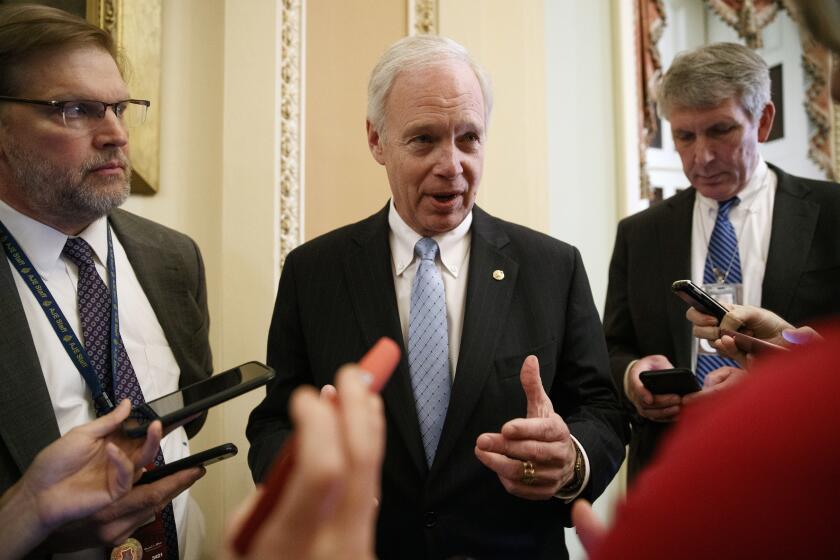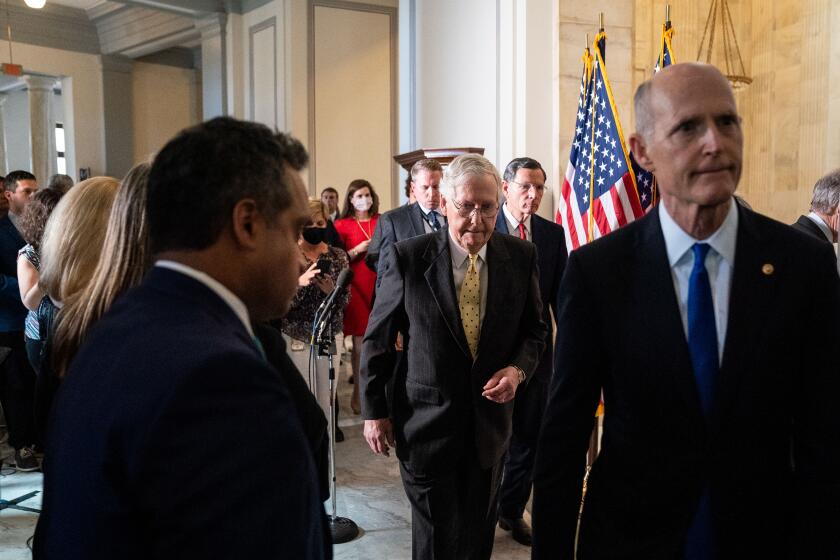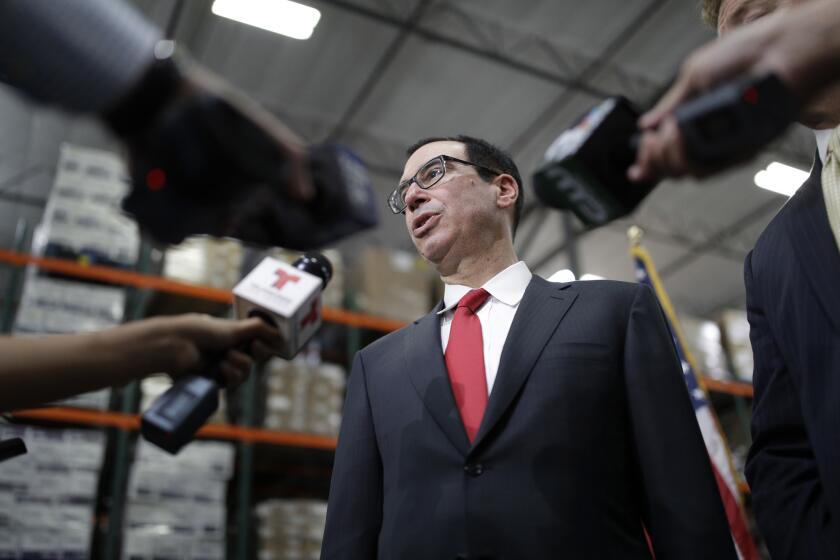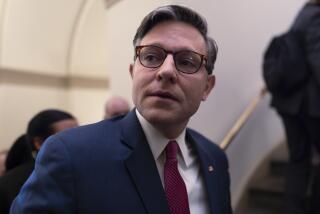Column: The U.S. economy is again being held hostage to our ridiculous federal debt ceiling
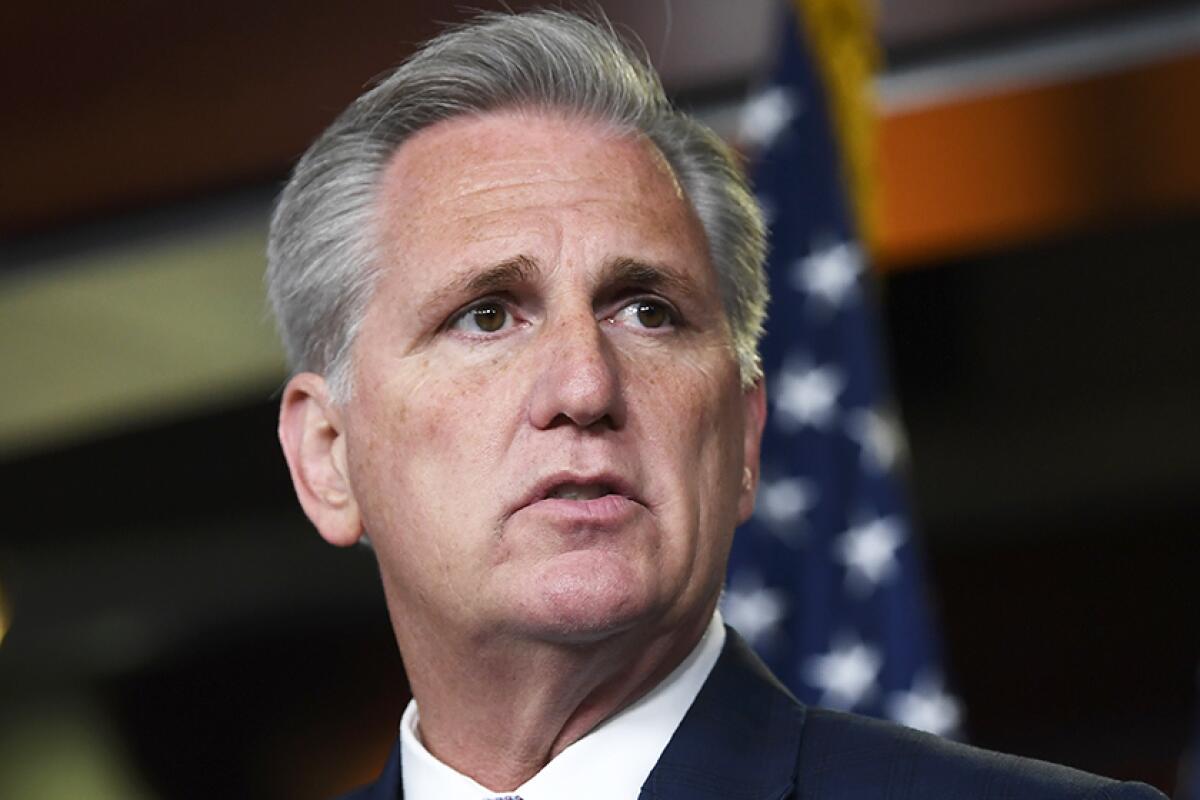
- Share via
The individuals in charge of U.S. fiscal policy are often thought to be among the most sober people in the world, so you may be wondering why we’re suddenly hearing ideas such as the minting of a trillion-dollar platinum coin or selling $100 face-value Treasury bonds for $200.
Sadly, the answer is simple: Infantile poseurs in the House Republican majority are threatening to block an increase in the federal debt ceiling. Again.
Republican brinkmanship over the debt ceiling has become almost an annual affair. It regularly causes shudders in the financial markets and warnings that provoking a federal default on Treasury securities — presumably the ultimate consequence of a long-term standoff — will have dire effects for Americans in all walks of life and for global economic stability.
The rabble-rousing Republicans who prolonged the House leadership election have made clear that a ‘clean’ debt-ceiling increase — in which lifting the borrowing limit is not coupled with other measures — should not even be on the table.
— Michael Strain, American Enterprise Institute
Congressional Democrats have had many opportunities to remove this weapon from the arsenal of ignorant pyromaniacs in the Republican Party, most recently during the lame duck session in late 2022 when they controlled both houses of Congress and the White House. Inexplicably, they failed to do so, and here we are.
On Friday, Treasury Secretary Janet L. Yellen warned House Speaker Kevin McCarthy (R-Bakersfield), as well as the other congressional leaders and key committee chairs, that the U.S. debt would reach the statutory limit Thursday, months earlier than had been expected.
Get the latest from Michael Hiltzik
Commentary on economics and more from a Pulitzer Prize winner.
You may occasionally receive promotional content from the Los Angeles Times.
At that point, Yellen said, the Treasury would start taking “certain extraordinary measures” to stave off a default. These include suspending scheduled payments into government employee pension funds.
Yellen said that once the political impasse ends, the funds would be made whole. That may not be so easy, however.
As a result of a three-month standoff in 2003, one federal retirement fund permanently lost $1 billion in interest because it had to sell government securities before they matured in order to meet obligations to retirees.
Before delving further into the consequences of a debt ceiling standoff and the possible counteractions, let’s once again review what the thing is.
The debt ceiling is a federal law that sets a limit on how much debt the Treasury can sell. At this moment, the limit is $31.381 trillion, which was set by Congress in December 2021.
With the U.S. economy on the line, the GOP again threatens to block an increase in U.S. debt limit.
Obviously, what Congress decrees, Congress can undecree. The debt ceiling has been raised by congressional votes more than 91 times since 1960, generally without discussion, by Democratic and Republican majorities and under Democratic and Republican presidents.
After Republicans took majority control of the House of Representatives in 2011, the debt ceiling turned into the raw material for political posturing. Typically, the GOP describes raising the debt ceiling as tantamount to encouraging profligate spending.
That’s the case now, when members of the House Republican majority, who have threatened to block an increase in the debt ceiling unless it’s paired with spending cuts, are carrying on as if blocking an increase in the ceiling is the same thing as halting the growth of the federal budget.
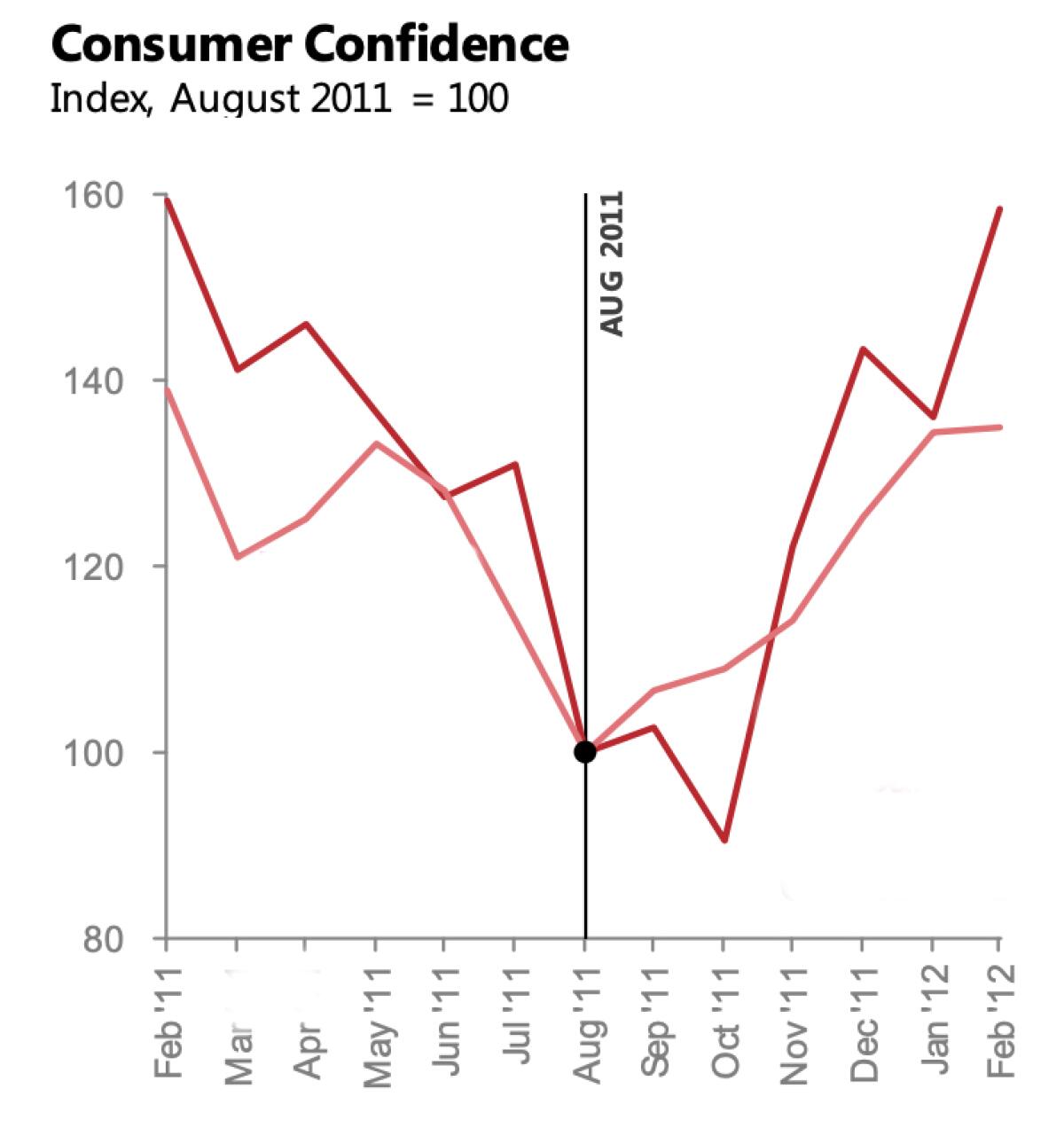
That’s false. It has always been false. The politicians making these statements know it’s false, which makes them liars.
The debt ceiling merely affects how the government pays for expenditures that Congress has already authorized. If the politicians didn’t want to spend the money, all they would need to do is refuse to appropriate it. They haven’t done that.
Instead, they’re behaving like credit card holders who have put more purchases on their cards than they feel like paying for, and thus have decided to stiff the card issuer in the belief that it will reduce their balances.
Why does the U.S. go through this stupid exercise, every nine months on average?
As I’ve explained many times, the debt ceiling was not originally meant as a limit on the Treasury’s authority to issue federal debt, but rather as a way to give it more latitude to borrow.
The debt ceiling came into being in 1917 when Congress grew weary of having to vote on every proposed bond issuance, which it considered a pain in the neck. So it chose instead to give the Treasury blanket authority to float bonds, subject to a stopgap limitation.
Republicans, fretting again over the national debt, skate over the role of their tax cuts for the wealthy.
In other words, the limit was never designed to keep Congress from enacting any spending bills or deficit-building tax breaks it wished. Obviously, it has never had that effect, since Congress routinely approves spending that it knows, by simple math, will require more borrowing.
Every time the debt ceiling is held for ransom by Republicans (it’s never done by Democrats), some pundits warn that this time the hostage takers may be serious and others express confidence that it always seems that way but everyone knows the standoff will ultimately be resolved, so why worry?
The undercurrent of complacency arises from the notion that the U.S. has never experienced the dire effects of a debt ceiling breach. This idea was most succinctly articulated by Mick Mulvaney, the fiscal battering ram then-President Trump appointed as budget director, who once said of the consequences of a default on U.S. government debt: “I have heard people say that if we don’t do it, it will be the end of the world. I have yet to meet someone who can articulate the negative consequences.”
Yet the negative consequences are and always have been evident to anyone who has matured beyond the point where they play with their toes.
Then-Treasury Secretary Timothy Geithner did so in January 2011, when he cited sharply higher interest rates on borrowings by state and local governments, credit cards, home mortgages; erosion of retirement nest eggs and home values; suspension of payments for military families and civilian government employees, on Social Security, Medicare and veterans benefits; the destruction of global confidence in the dollar and Treasury securities.
“Even a very short-term or limited default would have catastrophic economic consequences that would last for decades,” Geithner told congressional leaders.
Geithner was speaking in advance of a debt-ceiling impasse that lasted through the summer of 2011 and was finally resolved in August. The economic effects, however, lasted well into 2012. Consumer confidence fell 22% during the standoff and the Standard & Poor’s 500 stock market index, 17%. Household wealth fell by $2.4 trillion, the Treasury calculated.
The impasse was ended by the infamous sequester, which placed harsh spending cuts on the government for 10 years. It should be recalled that the sequester was devised to be so harsh that it would goad Congress and the White House into reaching a sensible budget compromise so it would not be invoked.
That perennial childishness, a fight over the U.S. debt ceiling, is back.
No deal happened, so the sequester went into effect, the entire experience resembling the act of staring into the barrel of a loaded shotgun and pulling the trigger to see if it works. The spending cuts inevitably fell hardest on the most vulnerable Americans.
Thousands of low-income residents of public housing were thrown out of their homes. Tens of thousands of 3- and 4-year-olds were barred from Head Start, perpetuating the vicious cycle of poverty and poor educational attainment faced by those families. Unemployment benefits were cut by an average of 15%.
Even conservatives are unnerved by the current level of posturing.
“Raising the debt ceiling merely allows for the borrowing that is needed to meet the obligations that Congress itself has created,” Michael Strain of the American Enterprise Institute, a business think tank, wrote last week. “The rabble-rousing Republicans who prolonged the House leadership election have made clear that a ‘clean’ debt-ceiling increase — in which lifting the borrowing limit is not coupled with other measures — should not even be on the table.”
Strain pointed the finger at McCarthy, who managed to squeak through to the House speakership by giving up any residual character he may have had to his own incendiary minority.
That brings us to the possible remedies. One recurrent idea is for the Treasury to order a $1-trillion platinum coin from the U.S. mint, deposit it at the Federal Reserve and transfer the value to its own books, thus creating a putative $1-trillion surplus as a cushion against a default.
Legal and fiscal experts have consistently confirmed that this procedure is legal, though it has been the target of scoffing from Yellen and President Biden, from back when he was a senator and President Obama’s vice president. But their objections seem aimed more at the basic gimmickry of the idea, not its legality or fiscal effectiveness.
Another idea is for the Treasury to offer “premium” bonds. The debt ceiling applies to the face value of outstanding debt, but technically nothing prevents the Treasury from issuing, say, bonds with $100 face values but selling them for $200, say by increasing their interest coupons twofold or more.
For buyers, the economic effect would be the same as buying two $100 bonds and collecting interest at the current rate on both. But from the debt ceiling standpoint, the Treasury would collect $200 but only issue $100 in new debt.
Buyers might purchase $100 face-value one-year Treasury bills, but instead of being promised 4.66% in interest (the current rate as I write), they’d be promised about 9.32%, for which they would pay $200. But only $100 would go on the Treasury’s books as issued debt.
Republicans have reportedly been working on their own anti-default scheme, which amounts to ordering the Treasury to “prioritize” spending, say by protecting interest payments on the debt and guaranteeing Social Security and Medicare payments.
But that leaves a lot uncovered, such as Medicaid, school lunches and food safety inspections. Once again, the neediest Americans are in the GOP’s crosshairs.
It’s one thing to decry the proposed remedies as gimmicks, but the debt ceiling itself has been turned into a gimmick. We’ve asked before if this is any way to run the world’s leading economy. To ask the question is to answer it. The time has come to stop running fiscal policy as a cabaret act and end the debt ceiling once and for all.
More to Read
Get the latest from Michael Hiltzik
Commentary on economics and more from a Pulitzer Prize winner.
You may occasionally receive promotional content from the Los Angeles Times.

